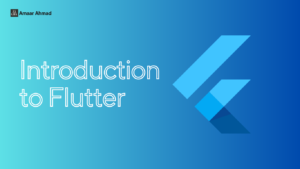Flutter, developed by Google, has emerged as a leading framework for building cross-platform mobile, web, and desktop applications. Its architecture is designed to be high-performance, flexible, and easy to understand, which is a key reason for its growing popularity among developers. In this blog, we will explore the architecture of Flutter and explain how its structure enables efficient and scalable application development.
1. Flutter’s Layered Architecture

The Flutter architecture is organized in layers, where each layer builds upon the previous one, ensuring a streamlined process for rendering visuals and handling user input.
- Framework Layer: The top layer of Flutter architecture is the framework layer, written entirely in Dart. It includes all the essential components developers interact with, such as widgets, rendering, animation, and gestures. The framework provides a reactive UI system that updates the view when the state changes.
- Engine Layer: Beneath the framework lies the engine, built using C++. This layer handles low-level operations such as rendering via Skia, Dart runtime, text layout, and input events.
- Embedder Layer: The embedder is responsible for integrating Flutter into the platform. It bridges communication between the engine and the underlying operating system (iOS, Android, Windows, etc.). The embedder handles tasks like rendering surfaces and accessing native services.
2. Flutter’s Reactive Framework
Flutter follows a declarative and reactive framework, inspired by React. In this system:
- Declarative UI: Developers define the UI based on the current state of the app. Whenever the app state changes, Flutter efficiently rebuilds only the parts of the UI that need updating.
- State Management: Since Flutter’s widgets are immutable, managing the state becomes crucial. Flutter offers several ways to handle state, including setState(), InheritedWidget, Provider, Riverpod, and Bloc.
The reactive approach in Flutter leads to fast UI updates and smoother user experiences, especially compared to imperative frameworks.
3. Widget Tree Structure
At the heart of Flutter’s architecture are widgets, which serve as the building blocks of any Flutter app. Everything you see on the screen, from text to animations, is a widget.
- StatelessWidget: A widget that doesn’t maintain any state. It renders its content based on the input parameters and does not change after the initial build.
- StatefulWidget: A widget that holds dynamic state. This widget can rebuild itself as the app’s state changes.
These widgets are organized into a tree structure called the widget tree, allowing developers to nest and arrange UI components easily. Widgets can also inherit from one another, making the design highly flexible and reusable.
4. The Role of Dart in Flutter Architecture
Flutter uses the Dart programming language, which plays a critical role in its architecture. Dart has several features that make it well-suited for Flutter’s reactive framework:
- Ahead-of-Time (AOT) Compilation: Dart compiles to native machine code, which ensures fast startup and high performance in production apps.
- Just-in-Time (JIT) Compilation: For development, Dart uses JIT compilation, allowing for hot-reload functionality. This feature enables developers to instantly see changes in the code without restarting the app.
Dart’s rich standard library and tooling further streamline the development process, while its object-oriented nature makes it easy for developers to grasp.
5. Rendering in Flutter
Flutter does not rely on platform-specific UI components. Instead, it renders everything from scratch using its rendering engine (Skia). Here’s how the rendering pipeline works:
- Layered Rendering: Widgets are drawn onto layers. These layers are then composited together to produce the final visual representation on the screen.
- Composition: Flutter uses a tree-based composition model where the framework combines individual pieces of UI to form the complete interface. This approach ensures flexibility in defining layouts and effects.
This complete control over rendering ensures that Flutter apps have a consistent look and feel across platforms, without relying on native components.
6. Cross-Platform Compatibility
One of Flutter’s strongest suits is its ability to support multiple platforms—Android, iOS, web, desktop—using a single codebase. The architecture is designed in a way that platform-specific code (via platform channels) can easily interact with the rest of the application. For example, using plugins or the embedder layer, Flutter apps can tap into platform-specific services like the camera, GPS, or accelerometer.
7. Performance Considerations
Thanks to Flutter’s architecture, performance is a primary focus. Here are a few reasons why Flutter apps perform exceptionally well:
- Skia Rendering: Using the Skia engine, Flutter ensures smooth rendering at 60 or even 120 frames per second (FPS) on devices that support it.
- Dart Native Compilation: Dart’s AOT compilation ensures near-native performance, especially on resource-heavy tasks.
- No Bridge for Rendering: Unlike other frameworks, Flutter does not need a JavaScript bridge to communicate with native elements. This reduces overhead and improves performance.
Conclusion
Flutter’s architecture is a well-designed system that emphasizes performance, flexibility, and simplicity. By leveraging Dart’s capabilities, a layered structure, and a declarative UI framework, Flutter allows developers to build beautiful, high-performance apps across multiple platforms with minimal effort. The architecture’s scalability also ensures that apps can handle growing complexity over time.
Whether you are new to Flutter or looking to optimize your development workflow, understanding its architecture is key to unlocking its full potential.
By mastering the layered structure, reactive framework, and widget system, developers can build powerful, scalable, and consistent cross-platform applications.
FAQs
The framework layer includes widgets, rendering, gestures, animations, and other higher-level tools for building the UI. It provides a declarative way to create user interfaces based on app state.
Yes, Flutter’s architecture is scalable. With efficient state management solutions and the ability to create custom widgets, developers can manage the complexity of large-scale applications with ease.
Yes, Flutter apps can integrate platform-specific code using platform channels. This allows Flutter apps to communicate with native services such as camera access, GPS, and more.



